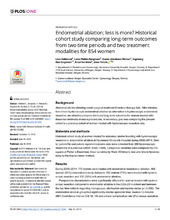| dc.contributor.author | Helleland, Liva | en_US |
| dc.contributor.author | Bergesen, Lena Flekke | en_US |
| dc.contributor.author | Rinnan, Karen Jakobsen | en_US |
| dc.contributor.author | Engelsen, Ingeborg Bøe | en_US |
| dc.contributor.author | Hordnes, Knut | en_US |
| dc.contributor.author | Trovik, Jone | en_US |
| dc.date.accessioned | 2020-08-05T11:11:11Z | |
| dc.date.available | 2020-08-05T11:11:11Z | |
| dc.date.issued | 2019-07-10 | |
| dc.Published | Helleland, Bergesen, Rinnan, Engelsen IB, Hordnes K, Trovik J. Endometrial ablation; less is more? Historical cohort study comparing long-term outcomes from two time periods and two treatment modalities for 854 women. PLOS ONE. 2019;14(7):e0219294 | eng |
| dc.identifier.issn | 1932-6203 | |
| dc.identifier.uri | https://hdl.handle.net/1956/23454 | |
| dc.description.abstract | Background: Abnormal uterine bleeding needs surgical treatment if medical therapy fails. After introduction of non-hysteroscopic endometrial ablation as alternative to hysteroscopic endometrial resection, we aimed to compare short and long-term outcomes for women treated with these two minimally-invasive procedures. A secondary goal was comparing the present cohort to a previous cohort of women treated with hysteroscopic resection only. Materials and methods: Historical cohort study of women treated for abnormal uterine bleeding with hysteroscopic resection or endometrial ablation at Haukeland University Hospital during 2006–2014. Similar patient file and patient-reported outcome data were collected from 386 hysteroscopic resections in a previous cohort (1992–1998). Categorical variables were compared by Chi-square or Fisher´s Exact-test, linear variables by Mann-Whitney U-test and time to hysterectomy by the Kaplan-Meier method. Results: During 2006–2014, 772 women were treated with endometrial resection or ablation, 468 women (61%) consented to study-inclusion; 333 women (71%) were treated with hysteroscopic resection and 135 (29%) with endometrial ablation. Preoperative characteristics were significantly different for women treated with hysteroscopic resection compared to endometrial ablation in the 2006-2014-cohort and between the two time-cohorts regarding menopausal, sterilization and myoma status (p≤0.036). The endometrial ablation group had significantly shorter operation time, median 13 minutes (95% Confidence Interval (CI) 12–14) and a lower complication rate (2%) versus operation time, median 25 minutes (95% CI 23–26) and complication rate (13%) in the hysteroscopy group, all p ≤0.001. The patient-reported rate of satisfaction with treatment was equivalent in both groups (85%, p = 0.955). The endometrial ablation group had lower hysterectomy rate (8% vs 16%, p = 0.024). Patient-reported satisfaction rate was higher (85%) in the 2006-2014-cohort compared with the 1992-1998-cohort (73%), p<0.001. Conclusions: Endometrial ablation has similar patient satisfaction rate, but shorter operation time and lower complication rate and may be a good alternative to hysteroscopic resection for treatment of abnormal uterine bleeding. | en_US |
| dc.language.iso | eng | eng |
| dc.publisher | PLoS | eng |
| dc.rights | Attribution CC BY | eng |
| dc.rights.uri | http://creativecommons.org/licenses/by/4.0/ | eng |
| dc.title | Endometrial ablation; less is more? Historical cohort study comparing long-term outcomes from two time periods and two treatment modalities for 854 women | en_US |
| dc.type | Peer reviewed | |
| dc.type | Journal article | |
| dc.date.updated | 2020-01-27T16:03:39Z | |
| dc.description.version | publishedVersion | en_US |
| dc.rights.holder | Copyright 2019 The Authors | |
| dc.identifier.doi | https://doi.org/10.1371/journal.pone.0219294 | |
| dc.identifier.cristin | 1721532 | |
| dc.source.journal | PLoS ONE | |

